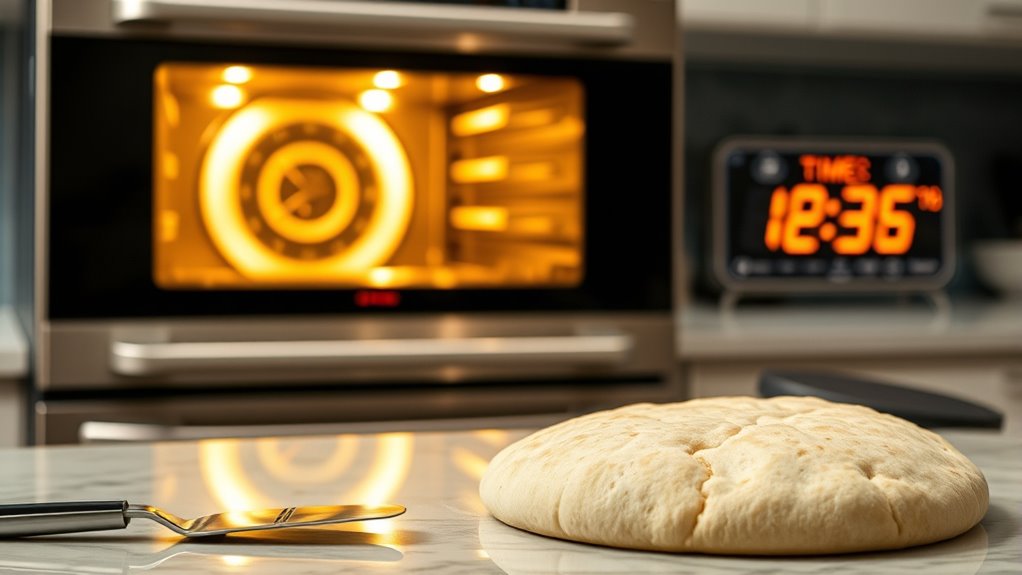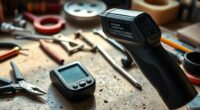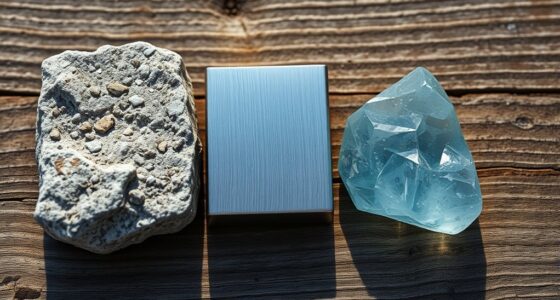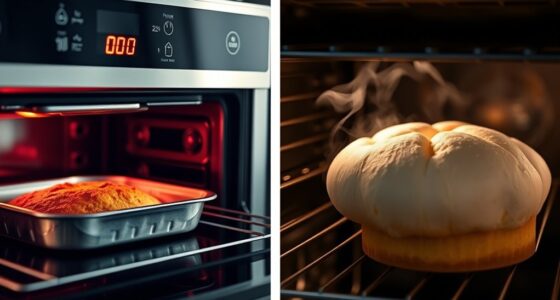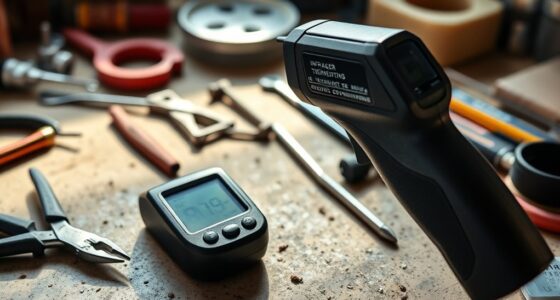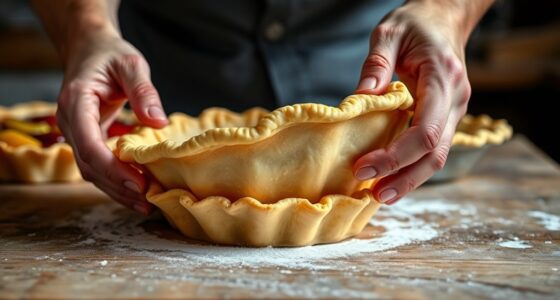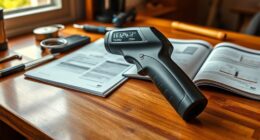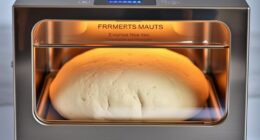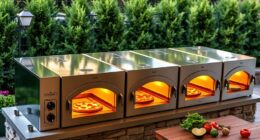To get perfect pizza crusts, you need to understand your oven’s true heating time and avoid rushing the preheat process. Use a thermometer to confirm when it reaches the right temperature, usually at the highest setting, and wait until the heat is even. Longer preheats help with dough thickness and setting the stage for crispiness. Keep your oven clean and experiment with timing—if you’re curious, there’s more to mastering preheat timing.
Key Takeaways
- Allow at least 15 minutes at maximum temperature for even heat stabilization before baking.
- Use an oven thermometer to verify accurate preheat temperature, not just the oven dial.
- Preheat well in advance, especially for different pizza styles and dough thicknesses.
- Keep the oven door closed during preheating to prevent heat loss and ensure even temperature.
- Practice and observe your oven’s response to determine optimal preheat duration for consistent results.
Understand Your Oven’s True Heating Time
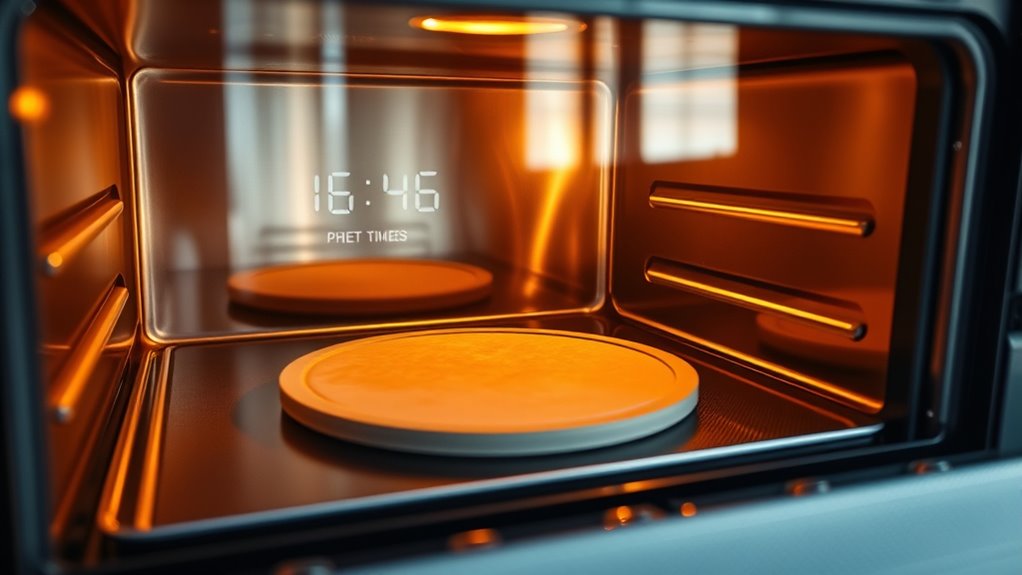
To make certain your pizza cooks evenly, it’s essential to know how long your oven actually takes to reach the desired temperature. This involves understanding your oven’s calibration, as many models heat unevenly or don’t reach the temperature displayed. Proper oven calibration ensures consistent heat distribution, so heat spreads evenly across the cooking chamber. Accurate temperature control is crucial for achieving the perfect crust and toppings. Without this knowledge, you risk under- or overcooking your pizza, resulting in uneven crust and toppings. To gauge your oven’s true heating time, set it to your target temperature, then use an oven thermometer to monitor how long it takes to reach that mark. Regular calibration and awareness of your oven’s heat distribution help you plan preheating better, ensuring your pizza cooks perfectly every time.
Avoid Rushing the Preheat Process
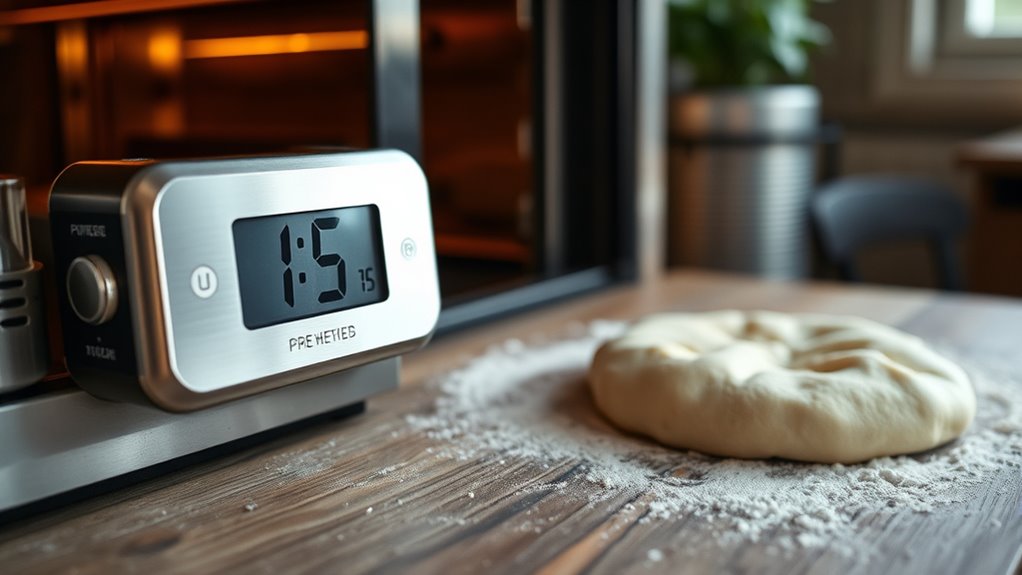
Rushing the preheat process can lead to uneven cooking and undercooked pizza. When you skip proper preheating, your oven’s temperature may be off due to poor calibration, affecting your results. It’s essential to give your oven enough time for the correct preheat duration, ensuring it reaches the ideal temperature. Rushing these steps risks burning the crust or leaving the center underdone, ruining your pizza experience. Remember, patience during preheating guarantees consistent heat, so your pizza cooks evenly every time. Here’s how rushing impacts you: Fostering a digital-friendly environment at home can also help you better understand your oven’s performance and troubleshoot issues.
Use a Thermometer to Confirm Temperature
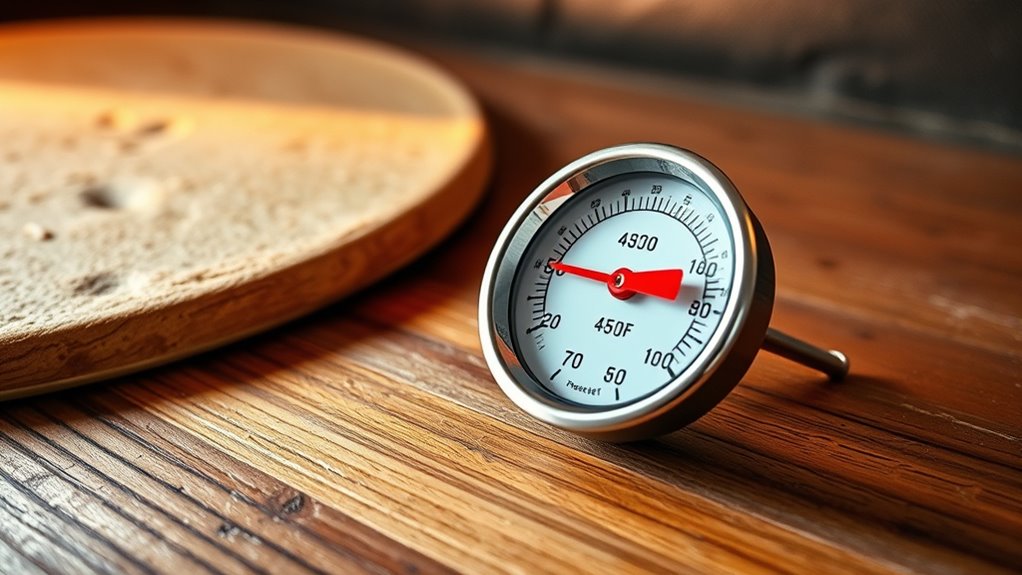
Using a thermometer helps you get an accurate reading of your oven’s temperature. Make sure to place the probe properly for consistent results, avoiding hot spots or false readings. Reliable measurements guarantee your pizza preheats perfectly every time.
Accurate Temperature Reading
Even though your oven’s dial indicates the correct temperature, relying solely on it can lead to inaccurate results. Over time, ovens can become uncalibrated, causing temperature fluctuations that impact your pizza’s quality. To guarantee consistent results, use a reliable thermometer to confirm the actual temperature. Regularly checking your oven calibration can help maintain accurate heat levels for optimal baking. Here are three reasons why this matters: 1. Avoid undercooking or burning—accurate readings ensure your oven hits the right heat for perfect crusts. 2. Improve oven calibration—regular checks help identify if your oven needs professional adjustment. 3. Save time and frustration—prevent guessing and re-baking by knowing the exact temperature. Inaccurate temperature readings can sabotage your pizza, so always verify with a quality thermometer for precise preheating.
Proper Probe Placement
To guarantee your oven reaches and maintains the correct temperature, proper probe placement is essential. When calibrating your oven, position the thermometer’s probe in the center of the oven, away from walls, racks, or heating elements. This ensures you get an accurate reading of the oven’s true temperature, not just hot spots or cold zones. Avoid placing the probe near the door or in corners, as these areas can fluctuate or be cooler. Proper probe placement helps you confirm the oven’s calibration and guarantees consistent preheat results. Remember, a well-placed probe offers real-time insights, enabling you to adjust preheating time accordingly and ensure your pizza cooks evenly at the right temperature. Additionally, understanding the importance of oven calibration can help maintain optimal cooking conditions for perfect pizza results.
Consistent Measurement Techniques
For accurate preheating, you need to rely on a reliable thermometer to confirm your oven’s temperature. Using proper measuring tools guarantees you’re not guessing, giving you confidence in your timing consistency. Here are three ways to improve your accuracy:
- Invest in a quality oven thermometer—it’s the only way to verify your oven’s true heat, not just what it displays.
- Check the temperature regularly during preheat, especially if your oven heats unevenly or has hot spots.
- Record the readings to track how your oven performs over time, helping you adjust preheat timing for perfect pizza every time.
- Incorporating passive voice detection tools can help identify and correct unclear or weak phrasing in your instructions.
Preheat at the Highest Setting for Crispy Crusts

Preheating your oven at the highest setting is essential for achieving a crispy crust on your pizza. When you set the oven to its maximum temperature, you create an ideal environment for that perfect crunch. The oven temperature directly impacts crust crispiness, making it golden and firm without burning. Remember, patience is key; wait until the oven is fully heated before baking. The right preheat guarantees even heat distribution, preventing sogginess. Here’s how it feels when you get it right:
| Feel the Heat | Crust Texture | Satisfaction |
|---|---|---|
| Searing hot | Crispy & golden | Perfect bite |
| Even warmth | No sogginess | Delicious crunch |
| Instant sizzle | Firm crust | Pizza bliss |
Additionally, understanding the preheating process can help you optimize your baking results for consistently delicious pizzas.
Wait for the Oven to Reach Even Heat
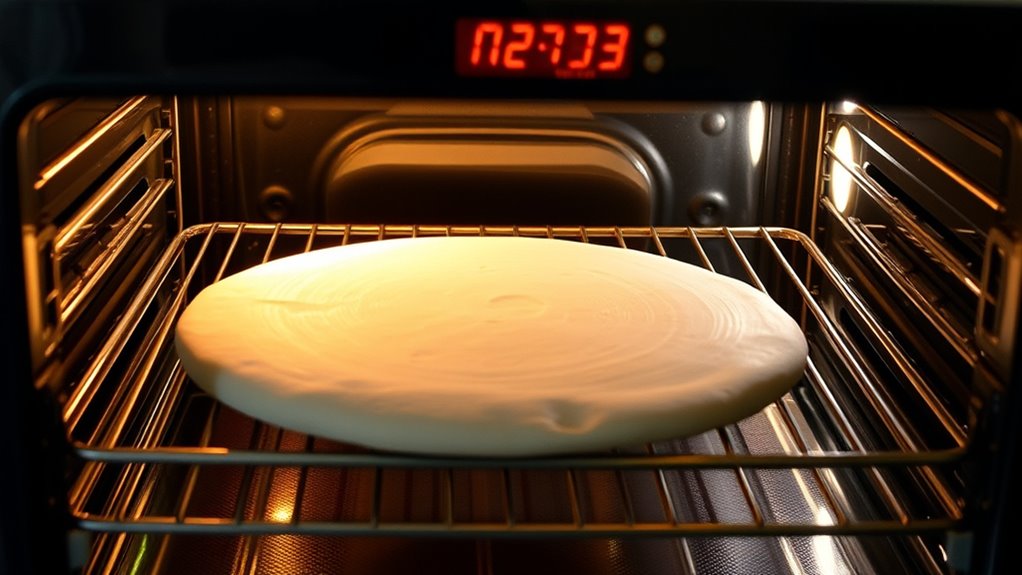
Once the oven reaches its maximum temperature, patience pays off. Waiting guarantees even heat distribution, essential for a perfect pizza crust. During this time, the oven’s heat retention stabilizes, preventing hot spots that could burn your pizza. Proper oven calibration plays an important role—an uncalibrated oven won’t heat evenly, ruining your bake. Additionally, ensuring your oven’s cybersecurity is up to date can prevent potential disruptions during your cooking process. To optimize preheating: 1. Check calibration regularly to avoid uneven heat. 2. Allow the oven to run at full temperature for at least 15 minutes before baking. 3. Observe the heat distribution through the oven’s vents or interior temperature gauge. This patience guarantees your pizza bakes evenly, with crispy edges and gooey toppings, making each bite worth the wait.
Know When to Turn Off the Oven After Preheating
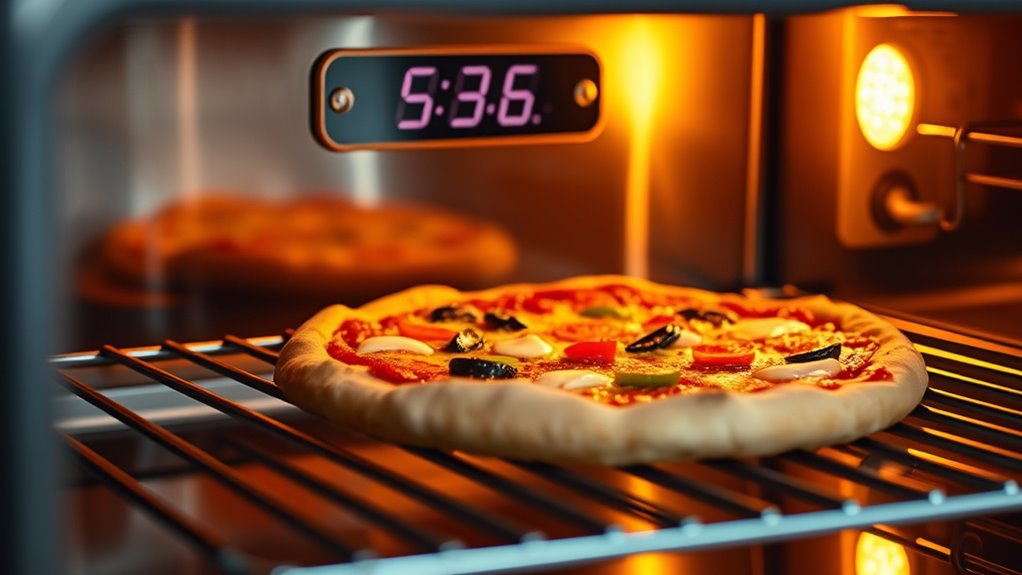
Once your oven reaches the right temperature, you need to know when to turn it off to prevent overcooking. Keep an eye on the heat levels and monitor the temperature to make certain it stays consistent. Adjust the settings as needed to match your pizza’s cooking time for perfect results. Additionally, understanding the preheat timing can help optimize your baking process and ensure your pizza is cooked evenly.
Recognize Optimal Heat Levels
Knowing when to turn off the oven after preheating is essential for achieving the perfect pizza crust. To recognize ideal heat levels, you need to trust your oven’s calibration and how well it retains heat. Here are key signs:
- The oven maintains a steady temperature without fluctuations, indicating good heat retention.
- The thermometer reads a consistent target temperature, confirming proper oven calibration.
- You notice the oven’s internal surface feels evenly hot, ensuring even cooking.
- Ensuring the proper oven temperature is crucial for consistent baking results.
Monitor Oven Temperature
Monitoring the oven temperature after preheating guarantees you turn it off at the right moment for ideal pizza crust. Use an oven thermometer to verify if your oven’s temperature matches the calibrated setting, as oven calibration can drift over time. Proper thermal insulation helps maintain consistent heat, but even well-insulated ovens need regular temperature checks. If your oven runs hotter or cooler than desired, adjust accordingly before baking. Keeping an eye on the thermometer ensures you don’t overheat, which can lead to a burnt crust, or underheat, resulting in a soggy base. Accurate temperature monitoring allows you to stop preheating at the most suitable time, setting the stage for perfectly cooked pizza with a crispy crust and evenly melted toppings. Additionally, understanding how projector contrast ratios influence image quality can help you optimize your viewing environment for the best cinematic experience.
Adjust for Cooking Time
To guarantee your pizza cooks perfectly, you need to adjust your oven’s temperature based on the expected cooking time. Proper oven calibration ensures the temperature you set matches actual heat, preventing under- or overcooking. Keep in mind that ingredient temperature also impacts cooking; ingredients straight from the fridge slow down the process. To master this, consider these steps:
- Calibrate your oven regularly to maintain consistent heat, so your pizza reaches the ideal internal temperature without guesswork.
- Adjust your preheat time based on your ingredient temperature—frozen or cold ingredients require longer cooking, so turn off the oven slightly earlier.
- Monitor your pizza closely during the final minutes to prevent burning or undercooking, ensuring perfect crust and toppings.
Preheat Well in Advance of Baking Time
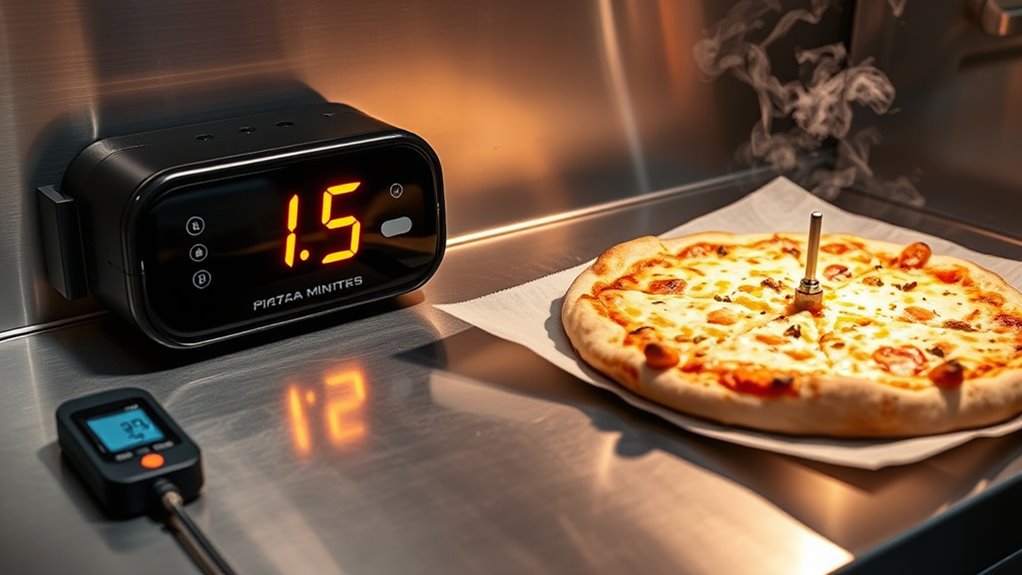
Preheating your oven well before you start assembling your pizza guarantees it reaches the ideal temperature by the time you’re ready to bake. This allows the oven’s heat retention to stabilize, ensuring consistent results. Proper oven calibration is essential; an uncalibrated oven may not reach or maintain the correct temperature, affecting your pizza’s texture and crust. By preheating early, you give the oven time to adjust and stabilize, minimizing temperature fluctuations during baking. This step is especially important if your oven heats unevenly or has a reputation for losing heat quickly. Remember, patience pays off—early preheating helps you achieve that perfect, crispy crust and evenly cooked toppings every time. Don’t rush this process, or you risk compromised results.
Don’t Open the Oven Door Too Soon
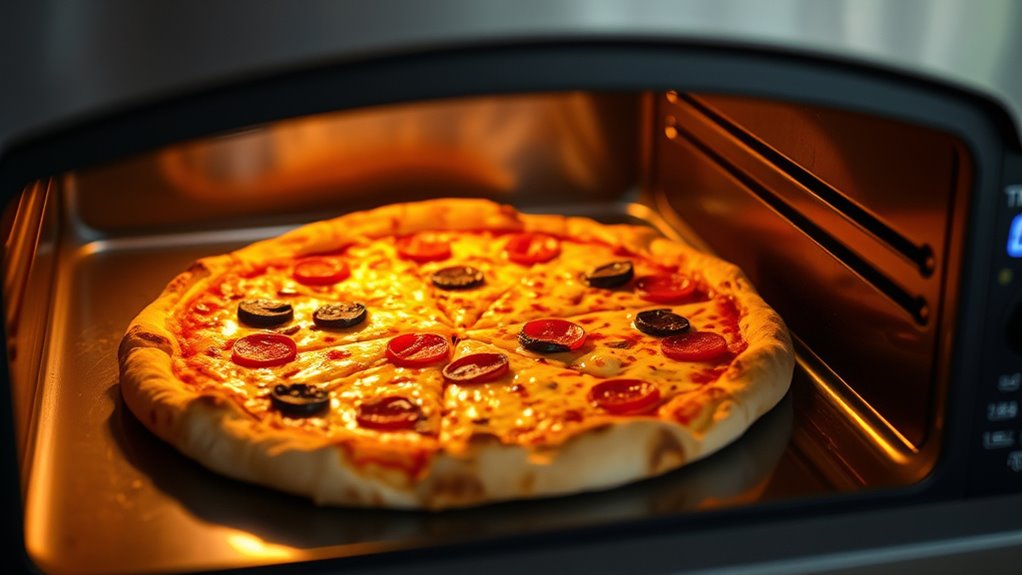
Opening the oven door too soon causes a sudden drop in temperature, making it harder to cook your pizza evenly. This can lead to a soggy crust and uneven toppings. For the best results, resist the urge to peek until the pizza is nearly ready.
Retain Oven Heat
If you open the oven door too soon, you risk losing the heat needed for a perfectly cooked pizza. This sudden drop can compromise oven insulation, making it harder to reach ideal temperatures. To retain oven heat, keep the door closed long enough for the heating element to stabilize. Remember, frequent door openings can reduce the oven’s ability to maintain consistent heat, affecting both oven insulation and heating element longevity.
Consider these points:
- Your pizza cooks evenly, avoiding soggy bottoms and undercooked centers.
- The oven maintains a stable temperature, saving energy and time.
- The heating element endures longer, reducing replacement costs.
Keeping the door shut ensures your oven performs at its best, delivering delicious results every time.
Prevent Temperature Drop
To keep your pizza cooking evenly and avoid undercooked or soggy spots, resist the temptation to open the oven door too soon. Opening too early disrupts heat retention, causing a temperature drop that prolongs cooking and affects crust crispness. Make certain your oven is properly calibrated for accurate heat, which helps maintain consistent temperatures. Use the following table to visualize heat loss:
| Oven State | Temperature Effect | Time to Stabilize |
|---|---|---|
| Door Closed | Maximum heat retention | N/A |
| Door Slightly Open | Moderate heat loss | 1-2 minutes |
| Door Fully Open | Significant heat drop | Several minutes |
| After Preheat | Stable heat for baking | N/A |
Avoid opening the door prematurely to prevent temperature drops and ensure your pizza bakes evenly.
Avoid Crust Sogginess
You should resist the urge to open the oven door too soon because doing so introduces cold air that can make the crust soggy. Early opening disrupts the baking process, compromising crust texture and baking consistency.
To avoid crust sogginess, keep these in mind:
- Patience is key—wait until the crust is golden and bubbling.
- Trust your oven’s heat—premature opening drops temperature and affects crust crispness.
- Use oven light to monitor progress instead of opening the door, preserving baking conditions.
Use the Right Bakeware for Better Heat Distribution
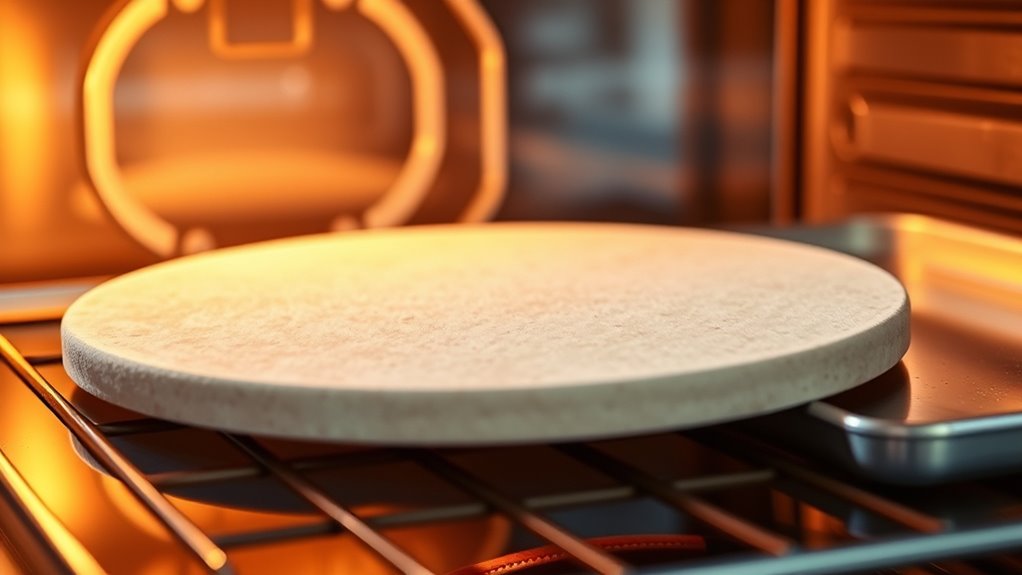
Choosing the right bakeware is essential for even heat distribution and achieving a perfectly cooked pizza. Select baking accessories like a perforated pizza pan or a dark, heavy-duty baking sheet, which promote better heat transfer. These materials help guarantee your crust cooks evenly without hot spots. Also, verify your oven calibration regularly, as an improperly calibrated oven can lead to uneven baking regardless of your bakeware choice. Using the correct bakeware paired with a properly calibrated oven helps maintain consistent temperatures, reducing the risk of undercooked or burnt spots. Remember, the right bakeware doesn’t just improve heat distribution—it also boosts your chances of a crisp crust and perfectly melted toppings. Invest in quality bakeware and keep your oven calibrated for the best pizza results every time.
Preheat With a Pizza Stone or Steel for Superior Results
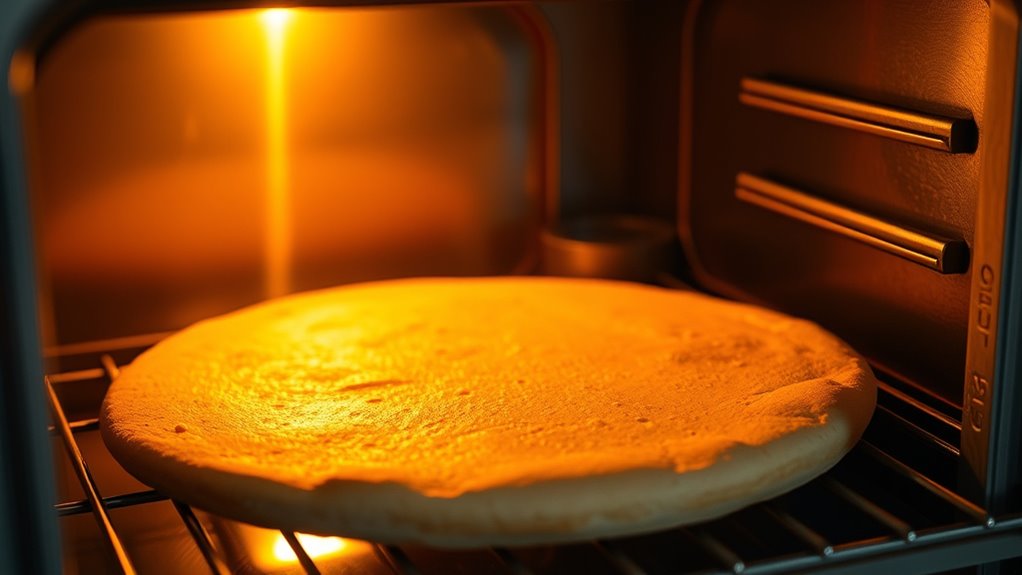
Preheating a pizza stone or steel is key to achieving a perfectly crisp crust and even cooking. When you properly preheat your pizza stone or steel, you liberate superior heat retention, ensuring your pizza cooks evenly from the bottom up. This method transforms your homemade pizza experience, delivering restaurant-quality results.
Preheating your pizza stone or steel ensures crisp crust and even cooking every time.
Here are three reasons why steel heating is a game-changer:
- Unmatched heat conduction that creates a beautifully crispy crust.
- Consistent heat distribution that prevents hot spots and undercooked areas.
- Reduced preheat time, so you get to enjoy your pizza faster.
Investing in a quality pizza stone or steel and giving it enough time to preheat guarantees a perfect bake every time. Your pizza will thank you.
Adjust Preheat Timing for Different Pizza Styles
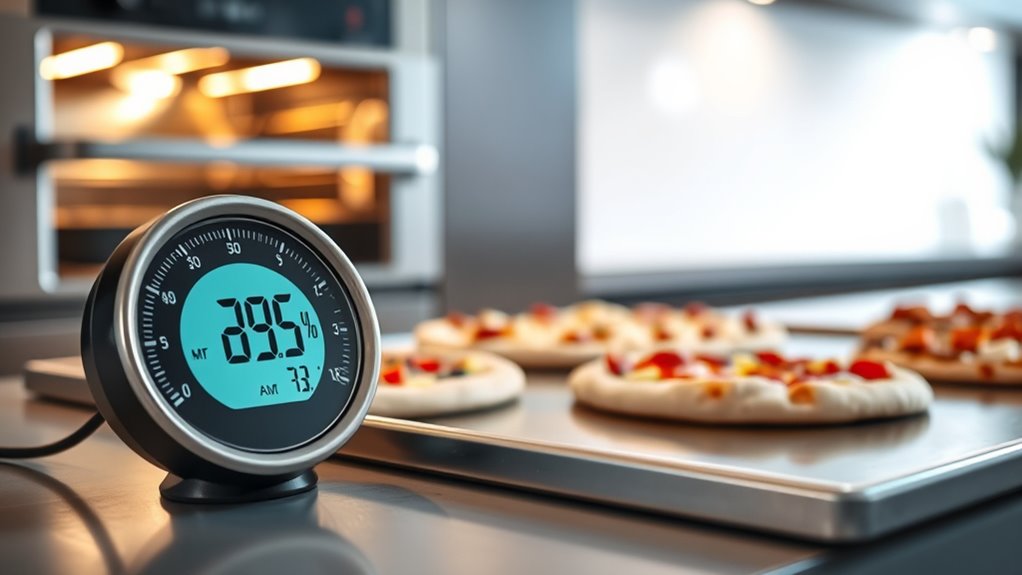
Different pizza styles require tailored preheat times to achieve ideal results. For thin-crust pizzas, a shorter preheat ensures a crisp bottom without overcooking the toppings. Thick-crust or deep-dish styles need a longer preheat to ensure even heat distribution, especially if your oven calibration is off. Temperature consistency is key; inconsistent heat can lead to uneven baking. Use the table below to adjust preheat times based on pizza style:
| Pizza Style | Recommended Preheat Time | Notes |
|---|---|---|
| Thin-crust | 15-20 minutes | For crisp crust, monitor oven calibration |
| Thick-crust | 20-25 minutes | Ensure even heat for thick dough |
| Neapolitan | 15-20 minutes | High heat, quick bake, check temperature consistency |
| Calzone/Stuffed | 20-25 minutes | Longer preheat for thorough baking |
Adjust based on your oven’s calibration to maintain ideal temperature consistency.
Consider the Thickness of Your Dough
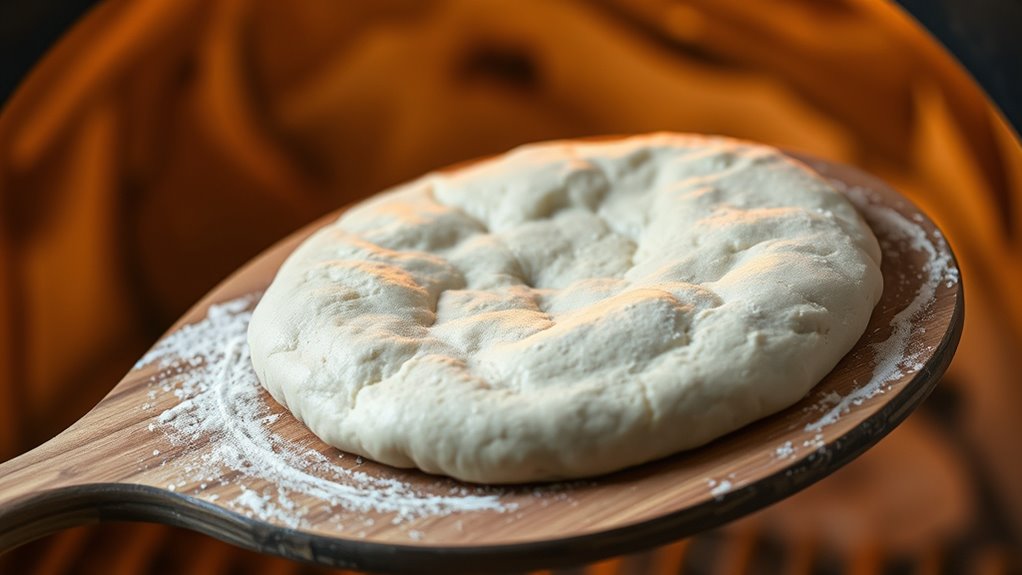
The thickness of your dough considerably influences how long you should preheat your oven. Thicker crusts require a hotter, longer preheat to develop that perfect crunch, while thinner crusts need less time to avoid burning. Your dough’s elasticity also plays a role—more elastic dough stretches easily, helping it cook evenly, but may need a different preheat approach.
- If your crust is thick, preheat longer at higher temperatures to achieve a crispy, golden crust without sogginess.
- For thin crusts, a shorter, hotter preheat ensures quick crisping without overcooking the toppings.
- Adjust based on dough elasticity—more elastic dough benefits from a slightly lower, steady heat to prevent over-expansion.
Consider these factors to optimize your preheat timing and craft the perfect pizza crust every time.
Use Convection Setting When Available
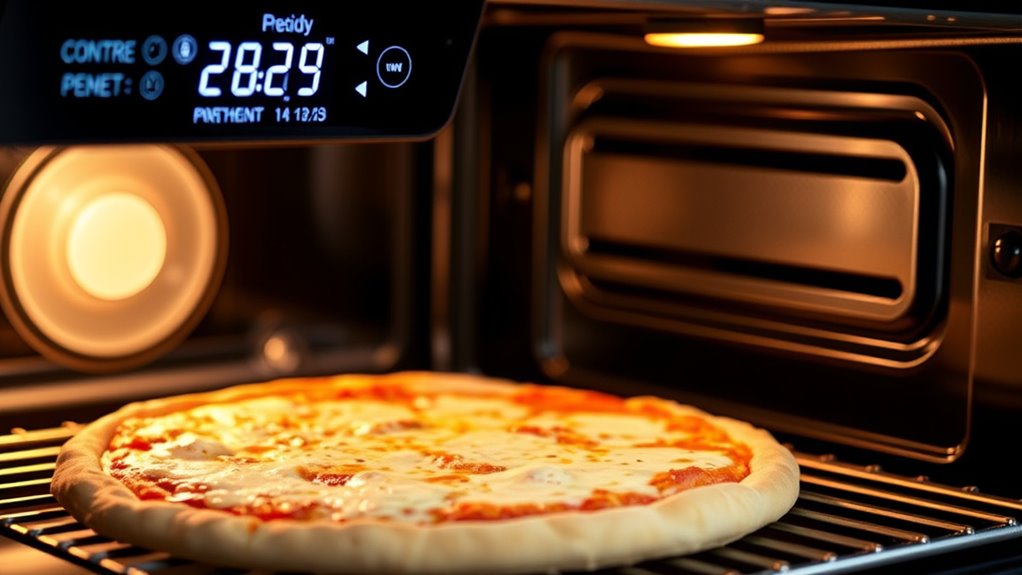
When your oven has a convection setting, it’s a valuable tool for achieving evenly cooked pizza crusts. Convection fans circulate hot air, promoting uniform heat distribution and reducing hot spots. To maximize this benefit, guarantee your oven is properly calibrated for accurate temperature consistency. If your oven isn’t well-calibrated, even the convection feature won’t deliver the best results. Using convection can cut preheat time slightly and help crisp the crust faster. Keep in mind, convection baking often requires lowering the temperature by about 25°F compared to conventional baking. This adjustment prevents overcooking and helps you hit that perfect crust. When available, always opt for the convection setting for preheating, especially when aiming for an evenly baked, golden crust.
Keep Your Oven Clean for Accurate Heating
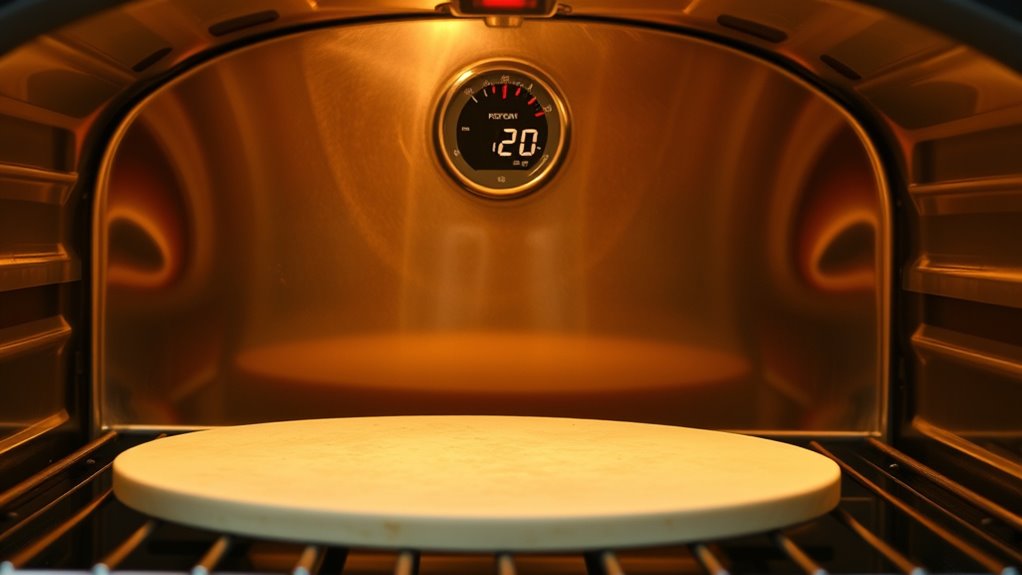
A clean oven guarantees consistent and accurate heating, which is essential for perfectly cooked pizza. When your oven is free of grease and residue, oven calibration stays reliable, ensuring the heat matches the settings. Establish a regular cleaning schedule to prevent buildup that can cause uneven heating or hotspots. Here are three ways keeping your oven clean impacts your pizza:
- Improves oven calibration precision, so every preheat is spot-on.
- Prevents temperature fluctuations caused by grime, ensuring even cooking.
- Extends your oven’s lifespan, maintaining ideal performance over time.
Practice and Observe to Find Your Ideal Preheat Timing
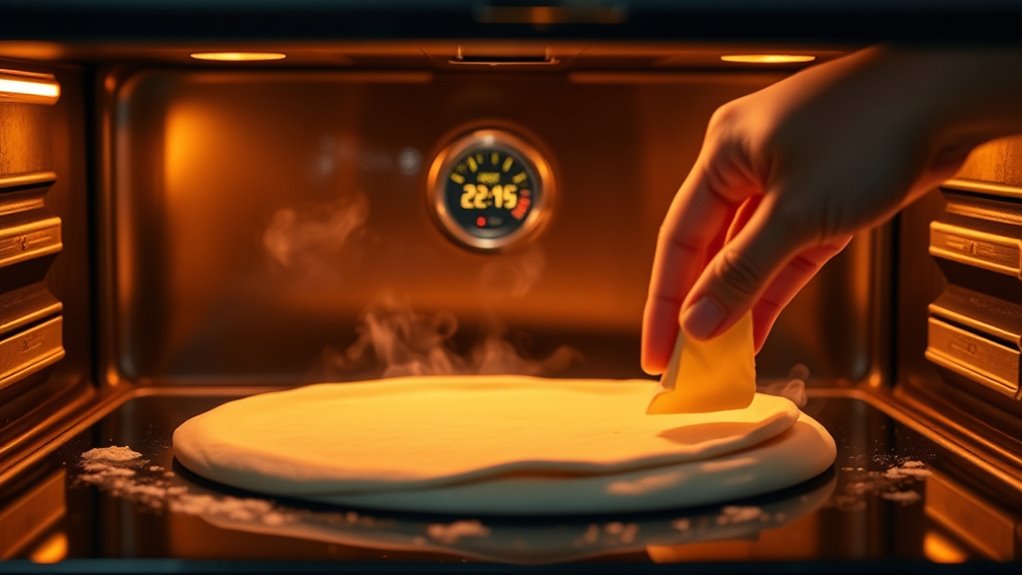
To find your ideal preheat timing, you’ll need to practice and carefully observe how your oven responds. Start by noting the preheat duration it takes to reach the desired temperature, considering your oven’s calibration. Every oven heats differently, so don’t rely on generic timings. Pay attention to how evenly it warms and how long it takes to stabilize at your target temperature. Make small adjustments to your preheat duration based on these observations. Keep track of your results to identify patterns. Over time, you’ll learn the most favorable preheat timing that results in perfectly cooked pizza crusts. Remember, consistent practice and attentive observation are key to mastering the right preheat timing for your specific oven.
Frequently Asked Questions
How Can I Tell if My Oven Heats Unevenly?
To check if your oven heats unevenly, place a baking sheet or an oven-safe thermometer on different rack levels and run it at a set temperature. If the readings vary considerably, your oven has thermal hotspots or may need calibration. You can also look for uneven browning on baked goods. Regular oven calibration helps correct these issues, ensuring even heat distribution and better cooking results.
What’s the Ideal Preheat Time for Thick Crusts?
You should preheat your oven for thick crusts for about 20-25 minutes to make sure it’s hot enough. Think of it as giving your oven time to get its act together, especially if it’s not well calibrated. Set the baking temperature to around 450-500°F, but keep an eye on your oven’s behavior. Proper preheating guarantees even cooking and a crispy crust, so don’t cut corners.
Can Preheating Influence Pizza Toppings’ Cook Time?
Preheating can definitely influence your pizza toppings’ cook time. When your oven reaches the right baking temperature, the heat quickly evaporates moisture from toppings, helping them cook evenly. If you don’t preheat enough, toppings may stay soggy or undercooked, especially with moist ingredients like tomatoes or cheese. To guarantee perfect results, always preheat your oven thoroughly, so the heat penetrates consistently and your toppings cook just right.
Should I Adjust Preheat Time for Different Oven Brands?
You should definitely adjust preheat time for different oven brands because oven calibration varies widely. Some brands heat faster or more evenly, meaning your usual preheat time might be off. By paying attention to your specific oven’s performance, you can fine-tune the preheat process, ensuring your pizza cooks perfectly every time. Don’t assume all ovens are the same—adapt your timing based on your oven’s brand and calibration for the best results.
How Does Ambient Room Temperature Affect Preheat Timing?
Your room temperature influences preheat timing because colder environments cause your oven to take longer to reach the desired temperature. If your room is cool, expect a longer preheat, especially if your oven’s calibration isn’t perfect. Conversely, warmer rooms might reduce preheat time. Always consider your oven’s calibration, as it affects how accurately it reaches and maintains the set temperature, ensuring your pizza cooks evenly.
Conclusion
Mastering your oven’s preheat timing is like tuning a fine lute; it takes patience and practice. Don’t rush the process—wait for that perfect, even heat, just like bakers did in ancient times. Use a thermometer, keep your oven clean, and experiment until you find what works best for your pizza. Remember, even the best chefs of yore knew that good things come to those who wait—so trust the process and enjoy your delicious creation.
